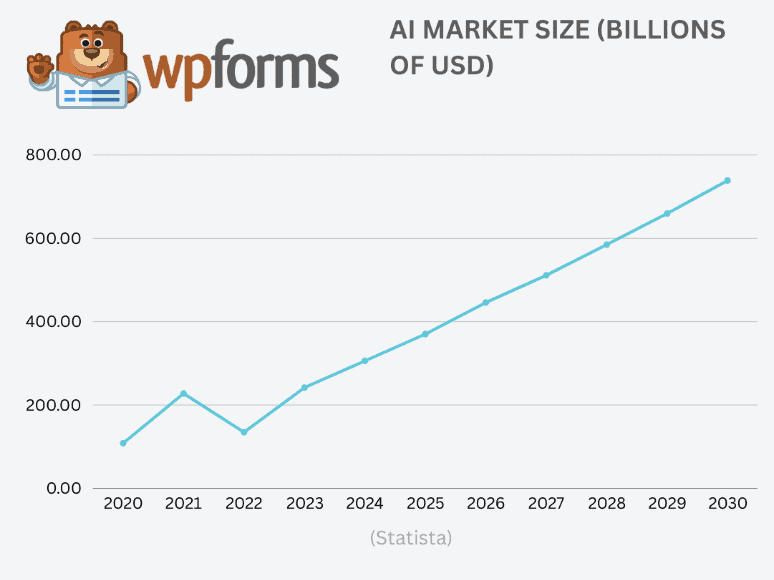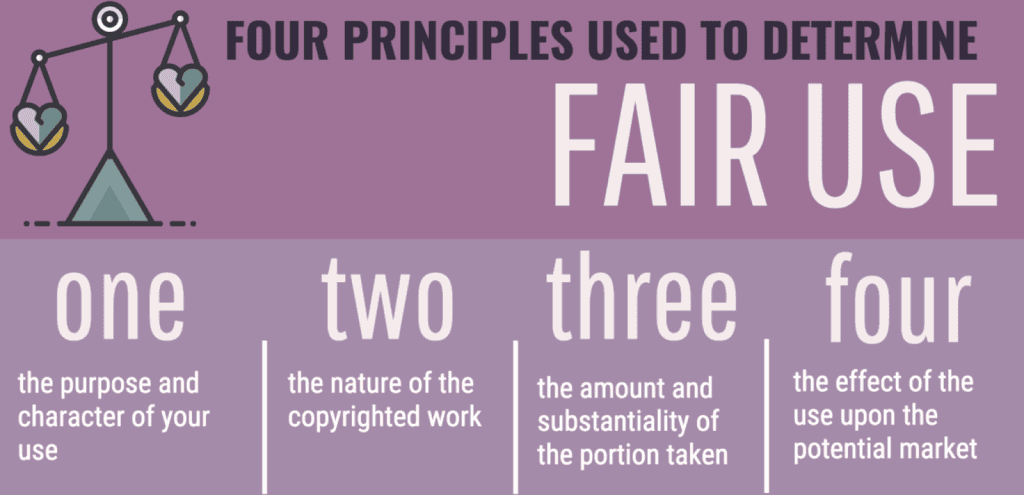Fair use is one of the most important concepts in copyright law; it provides flexibility for individuals and institutions to use copyrighted material without explicit permission under certain conditions.
The four most important factors around fair use include the purpose, the nature of the copyrighted work, how much of the material was used, and the effect on the market for the original work.
As I’m sure you know by now, artificial intelligence (AI) has exploded in popularity and is fundamentally changing everything we do. It’s currently worth 241.8 billion dollars and is expected to continue growing.
These tools can generate text and images, analyze gigantic datasets, and so much more. It’s worth mentioning that we are, in my opinion, still in the infancy stage of this technology.
As a result, creativity and copyright rules are being reshaped. This raises questions about the boundaries of fair use in areas like training datasets, content ownership, and copyright compliance.
Today, we will discuss the relationship between AI and fair use and share actionable advice for creators, businesses, and folks who are using AI day-to-day.
Let’s dive in!
Table of Contents
How AI is Currently Affecting Fair Use
First, it’s important to understand the impact AI is currently having on copyright and fair use. When you look at what’s happening now, you can start to figure out what the future might look like.

AI Training Data and Copyright Infringement
The typical training for AI systems, whether it be large language models or image generators, is on vast datasets containing text, images, music, and videos. These datasets usually contain copyrighted works scraped from publicly available platforms or sourced through licensed repositories.
The goal of this training is to teach AI how to recognize patterns and generate outputs that mimic human creativity, which has worked to varying degrees of success.
As I’m sure you can imagine, this crosses critical legal lines. Specifically, most people want to know if using copyrighted material to train an AI is an infringement or is fair use.
AI advocates would say that training data is used in transformative ways: the AI does not reproduce the original content; rather, it abstracts patterns to create new works.
However, critics say that even such indirect use is an exploitation of copyrighted material, especially when the original creators did not agree to the use of their works. This makes it a serious copyright infringement issue.
Legal cases are just beginning to address these issues. The New York Times is currently suing OpenAI and Microsoft in federal court. The NYT argues that each of their prints is copyrighted and paywalled. One of their terms explicitly says that the work cannot be copied. Since these AI tools are scraping content, a person could use the right prompts to reproduce their paid content. This means it will directly impact their revenue and disregard their terms of service.
The case has not yet been wrapped up, as the NYT lawyers are still inspecting OpenAI’s code and building their case. But one thing’s for sure: no matter how this ends, it will likely set a precedent for the future of fair use and AI.
AI-Generated Content and Ownership
The rapid proliferation of AI-generated content introduces thorny questions about copyright ownership.
Traditional copyright law requires human creativity for authorship, begging the question: can AI be considered an author, or does the copyright reside with the user who prompted the AI or the developer who developed the model?
The Copyright Office in the United States has, to date, rejected the notion that AI-generated works can be copyrighted because there is no human authorship.
However, China has recognized certain AI-generated work as copyright-protected. If this sets the stage for the future, it will be interesting to see how we reckon with the idea of AI-generated content being protected.
What makes this all the more interesting is there is also a dispute as to who has what rights between the developers and users of AI-generated content. Such ambiguity calls for clear international guidelines that will ensure ownership and fair compensation for creators and developers alike.
AI as a Fair Use Checker
Under the right circumstances, AI can review similarities between works in order to decide whether a use is transformative or measure the potential market harm of a derivative work. Such tools could provide preliminary insights that reduce the burden of manual analysis and yield faster decision-making.
However, there are limitations to the use of AI in fair use analysis: AI systems are only as good as their training data, which may contain biases or be incomplete. They also lack the ability to understand nuanced legal or creative contexts, such as the intent behind a particular transformative use or the cultural importance of a given work.
While having these limitations, AI-powered fair-use tools go some way in democratizing access to knowledge on copyright. They are especially useful for smaller creators and organizations that can’t afford expensive legal resources. Still, users of the tools need to exercise caution when applying them, knowing their limitations and complementing them with human expertise where necessary.
Holger Sindbaek, serial entrepreneur and the founder of the brain training platform Online Solitaire, says, “Fair use challenges were a recurring hurdle when managing content for our platform, especially with UGC materials and marketing assets. The manual process of assessing potential conflicts was slow and left too much room for error, which could jeopardize the platform’s growth. Implementing AI-powered fair use tools allowed us to streamline the initial review process—quickly identifying similarities and flagging areas of concern. While these tools provide a solid foundation, we’ve learned that their real value comes when paired with human expertise. By combining AI’s speed with thoughtful manual oversight, we’ve built a scalable approach that saves time and ensures each decision reflects both efficiency and fairness. As these tools evolve, they become indispensable for businesses looking to balance innovation with compliance.”
Future Implications of AI on Fair Use
Next, we will take a glimpse ahead and try to figure out what the future of AI and fair use could look like. Let’s start with a quote from Sam Altman, co-founder and CEO of OpenAI:
Transformation of the Fair Use Principles
As AI technology fundamentally changes creative work and industries, it’s putting pressure on traditional principles of fair use and copyright law to evolve.
Since fair use has traditionally rested on human-centric concepts of authorship, originality, and intent, this adds new dimensions to the equation.
One major issue here is that of authorship. AI systems generate works based on large datasets, but the works produced do not have a human creator in the traditional sense.
It raises questions of how fair use could apply to works that are neither in the traditional sense authored nor derivative. The transformative use doctrine also becomes more ambiguous when one has AI outputs—for instance, when an AI, inspired by thousands of copyrighted works, generates an image: Is that a transformation or just recombination?
Let’s break down these four factors and explain how they can impact fair use.

- Purpose and character – AI outputs can be transformative, but they lack human intention, which makes this analysis very difficult.
- Nature of the original work – AI often draws from highly creative sources like art and music, which receive stronger copyright protections.
- Amount and substantiality – It is difficult to gauge the extent of usage in AI training because of the large size of data sets. There should be a line, but it’s very much blurred.
- Market impact – The AI outputs could hit the markets with derivative or competitive works, which is bound to affect the value of original creations.
As these challenges grow, courts and lawmakers may need to reinterpret fair use principles to account for AI’s unique characteristics, balancing innovation with creators’ rights.
Impact on Creative Industries
AI can scale up content generation and may shake up the traditional creative industries, bringing opportunities and risks to artists, writers, musicians, and other creators. While AI tools can enable greater creativity and productivity, they also threaten to commoditize artistic expression and disrupt established business models.
In a way, it is exciting for individual creators: writers can use AI to overcome writer’s block or come up with new ideas; likewise, visual artists can try out new AI-driven tools to see new dimensions of their style.
For entrepreneurs exploring innovative online business ideas, these open up new possibilities, from creating AI-enhanced content to launching automated services.
Musicians can team up with AIs and create works without privileged access to expensive creative tools.
However, it also comes with associated risks. In fact, this rush of AI-generated content could devalue original works and make competition very hard for human creators who are not interested in using these tools.
For instance, AI-generated counterparts are competing with stock photo markets and music licensing platforms. Such an abundance of low-cost, automated creations could erode the market for traditional works and result in photo galleries that are more AI than supported with human skill and creativity.
Copyright law becomes important in the middle of these tensions. If the laws are not adapted, creators may end up accidentally stealing licensed work due to what the AI produced. On the other hand, regulations that are too restrictive might choke the development of AI technologies and access to new innovative tools.
There will need to be a balance between creators, developers, and consumers. The policymakers should consider how copyright frameworks will stimulate human creativity and technological innovations together in such a way that creative industries’ ecosystems should become sustainable.
New Laws and Regulations
The likely response to these challenges that AI poses to fair use and copyright will be new laws and regulations. Such updates shall strive to balance the interests of creators, AI developers, and users while fostering innovation and fairness.
A very critical area that needs reform is the regulation of training datasets. Clear guidelines on what data can be used in training AI—be it through licensing, public domain restrictions, or fair use exemptions—would provide legal certainty.
In addition, transparency requirements for AI developers could be helpful in ensuring that the ways in which data is acquired respect copyright laws.
Another aspect is the copyright status of AI-generated work. While some jurisdictions, like the U.S., currently exclude non-human creations from copyright protection, others are looking at ways to grant limited rights to AI-generated works.
A harmonized approach to these issues could prevent international discrepancies and foster consistent standards. It also poses enforcement challenges, such as monitoring and controlling the explosive spread of AI creations without suppressing legitimate uses.
Only through concerted international cooperation—at all levels—will common standards that successfully cross boundaries be developed. They need to strike a very fine balance—protecting the rights of creators, enabling innovation in AI, and making sure that the benefits of such technologies are fairly shared with all of society.
Practical Tips for Navigating Copyright and AI
Now, let’s look at a few tips for folks who want to navigate AI, fair use, and copyright law.
For Creators
- License and Protect Your Work – Consider using tools like Creative Commons licenses or digital rights management (DRM) to clearly define how your work can be used. Watermarking digital content can deter unauthorized use.
- Use AI Tools Responsibly – Familiarize yourself with the terms of service of any AI tools you use to ensure your work is not unintentionally used in datasets. There’s often an option to turn it off based on what you’re using.
- Document Your Creative Process: Keep records of your inputs and edits when using AI tools. This type of documentation can help establish authorship and protect your rights if there’s a dispute or question about your work.
For AI Developers
- Respect Copyright Laws: Always make sure your models are trained on datasets that are legally sourced, whether through licensing agreements or the use of public domain materials. You don’t want to ignore this until it’s too late and laws are passed.
- Be Transparent About Data Usage: Clearly disclose how your AI system processes data and generates content. Transparency is very important for building trust and helps users understand the copyright implications of their AI-generated works.
- Adopt Ethical Practices: Engage with creators and legal experts to develop policies that respect intellectual property while also encouraging innovation.
For Users of AI-Generated Content
- Verify Copyright Status: Before using AI-generated content, confirm its copyright status and ensure it does not infringe on the rights of others. You can sometimes do this with a quick search.
- Understand Platform Terms: Read the terms of service for AI tools to avoid unintentional copyright violations.
- Use Content Ethically: Attribute AI-generated content appropriately and avoid passing it off as wholly original without clarification, as this could damage your reputation and cause legal roadblocks in the future.
Final Thoughts
There’s no doubt that AI has fundamentally changed the world, including how we see fair use. We will surely see even more changes in the coming years.
The best thing you can do right now is to make sure you’re familiar with the current laws and acting responsibly in how and where you use AI-generated content.
The bottom line is creators must take proactive steps to protect their work, developers must prioritize transparency and ethical practices, and users must remain vigilant about the legal and ethical implications of AI-generated content.
As we adapt to these changes, the focus should remain on fostering innovation while respecting the rights and contributions of human creators.
The future of fair use and copyright is still uncertain, but you can bet that AI will have an impact on what ultimately happens next.


